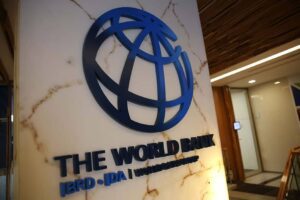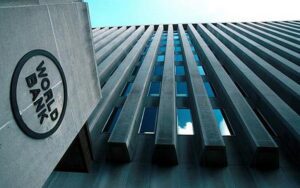
The World Bank may provide the Ministry of Infrastructure of Ukraine with financing in the amount of $250 million for the modernization of the railway.
According to a report on the bank’s website, the project is intended to increase the efficiency and financial stability of JSC Ukrzaliznytsia.
Financing of the project may begin in FY2022, which ends on June 30 at the World Bank.
In addition, according to a posting on the bank’s website, it may also provide Ukraine with $400 million in financing for the Road Safety Facility.
The purpose of this project, as noted in the report, is to support the implementation of the Vision Zero concept in Ukraine (an international program to improve road safety and reduce mortality in road traffic accidents).
Financing of the project may begin in FY2023, which starts at the World Bank on July 1, 2022.

Finance Minister Serhiy Marchenko and World Bank Regional Country Director for Belarus, Moldova and Ukraine Arup Banerji have signed a loan agreement for EUR 300 million in order to continue implementing economic recovery projects, the Finance Ministry said.
“The loan is the result of structural reforms in the areas of demonopolizing key sectors of the economy, strengthening anti-corruption institutions, improving the work of land and capital markets, as well as improving the social welfare system,” the ministry said on its website on Monday.
As part of further cooperation between Ukraine and the International Bank of Reconstruction and Development, the World Bank Country Partnership Strategy for 2022-2025 is being developed. Its goal is Ukraine’s achievement of sustainable economic recovery and growth. The priorities of the strategy will be energy, agriculture, and transport system, the Ministry of Finance said.
Ukraine received its first loan from the IBRD in the amount of $350 million for the development policy in the field of economic recovery in June 2021.

Investment in physical capital and infrastructure without sufficient investment in human capital may not give Ukraine the expected dividends, World Bank Vice President for Europe and Central Asia Anna Bjerde has said in an exclusive interview with Interfax-Ukraine.
Bjerde welcomed the fact that policymakers have identified priority areas and recognized the need to mobilize investment. She said this, commenting on the government’s intention to stimulate investment in “growth points” – priority sectors.
She emphasized one important aspect that has not been particularly highlighted in the government’s plans – the importance of human capital. Education, skills, experience, innovation and public health together is, according to a study, the most important resource for sustainable economic growth. This is glue that brings together other factors of production, including physical capital and infrastructure, she added.
As reported, the government has identified five priority clusters that can have the highest multiplier effect for Ukraine: technological production, energy security, life safety, transport and the City of Craftsmen, or the development of local, unique industries. According to the government, stimulating these “growth points” with investments in the amount of $1 billion will give the highest multiplier effect and will lead to economic growth by 1-2% of GDP.

The World Bank’s Board of Executive Directors on June 30 approved a $212 million financing package for private joint-stock company Ukrhydroenergo for installation of hybrid systems for electricity production.
“The project will enhance the flexibility of the Ukrainian power system to help synchronize it with the European electricity grid and decarbonize the power sector,” the World Bank said.
The $212 million financing package includes a $177 million International Bank of Reconstruction and Development (IBRD) loan, a $34 million Clean Technology Fund (CTF) concessional loan, and a $1 million CTF grant for a new project in Ukraine.
“The World Bank’s financing will help mitigate technical risks associated with synchronizing Ukraine’s power grid with the European electricity grid and will help decarbonize it by facilitating greater integration of renewable energy,” the World Bank said.

The Cabinet of Ministers of Ukraine and the World Bank have signed an agreement worth $350 million, Prime Minister Denys Shmyhal has said.
“The government and the World Bank signed an agreement worth $350 million. The funds will be used to develop the economy during the pandemic, provide social support to vulnerable groups and strengthen state institutions,” Shmyhal said on Telegram.
According to him, these funds will also help implement systemic projects for the fair development of the land market, continue the reform of the gas sector, and strengthen the credit market.

The World Bank’s Board of Executive Directors approved today $100 million in Additional Financing for the country’s COVID-19 response under the Ukraine Access to Long Term Finance Project, the funds of which will be used to support export-oriented small and medium-sized businesses.
“The World Bank’s Board of Executive Directors approved today $100 million in Additional Financing for the country’s COVID-19 response under the Ukraine Access to Long Term Finance Project,” the WB said on Saturday.
The Ukrainian state-owned Ukreximbank (UEB) is a borrower and implementing agency of the ongoing Bank project, the message reads.
“Bank project, Access to Long Term Finance, and the additional funds will be used by the UEB to provide loans to export-oriented small and medium enterprises (SMEs) affected by the COVID-19 pandemic. The project is focused on providing sub-loans of longer maturity than are currently present on the market,” the WB said.
“These new loans from Ukreximbank will create jobs, stimulate competitiveness, help Ukrainian companies find new customers abroad, increase revenues, and contribute to poverty reduction as Ukraine recovers from the pandemic,” the bank’s press service quoted Arup Banerji, World Bank Regional Country Director for Eastern Europe, as saying.
Implemented since the summer of 2018, the ongoing $150 million Access to Long Term Finance Project has already had a positive effect on Ukraine’s SME sector. More than 50 entrepreneurs from all over Ukraine had already received financial support as part of the project. The majority of SMEs supported by the project work in agriculture and food processing industries, where Ukraine’s exporters hold natural comparative advantages and where SMEs traditionally dominate. The project also provided loans to firms in various production industries: manufacturing of mining equipment and refrigerators, dental and electric equipment, plastic packaging, wood processing, carpet-weaving, etc.
The World Bank’s current investment project portfolio in Ukraine amounts to about $3.3 billion, in 11 ongoing investment projects and one Program for Results operation.